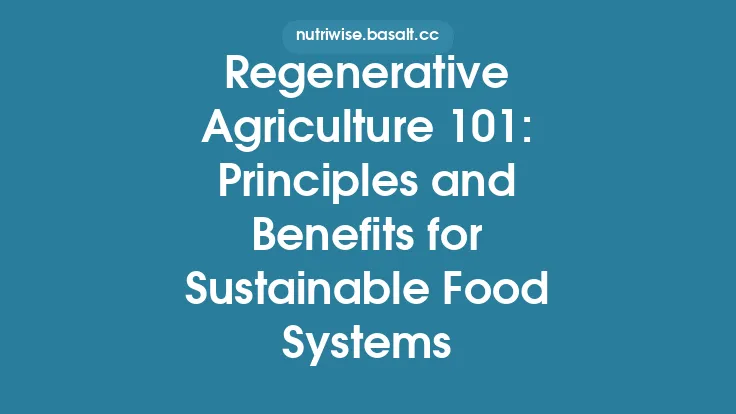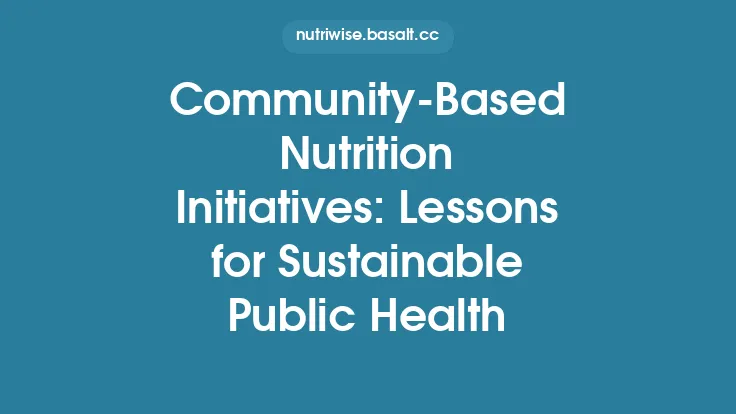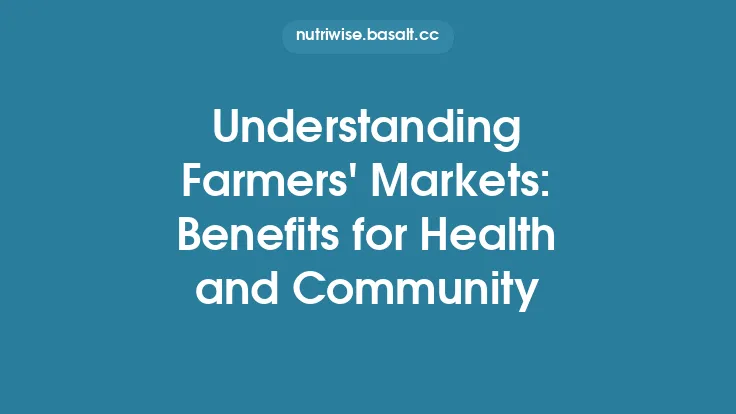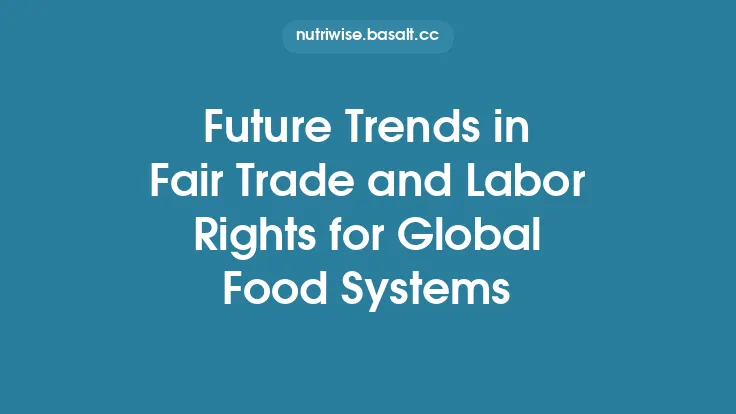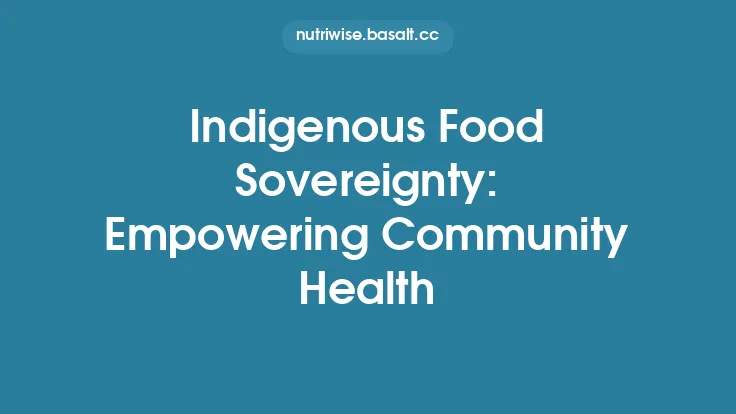Food security and public health are inextricably linked; when populations lack reliable access to safe, nutritious food, the burden of disease rises, health disparities widen, and the capacity of health systems to respond to other threats diminishes. Building resilient communities therefore requires a multidimensional strategy that integrates nutrition science, systems engineering, epidemiology, and socio‑economic policy. The following discussion outlines the core concepts, evidence‑based interventions, and implementation pathways that can sustain food availability, accessibility, utilization, and stability while simultaneously protecting and promoting public health.
Understanding Food Security in the Context of Public Health
Food security is defined by four interrelated pillars: availability, access, utilization, and stability. From a public‑health perspective, each pillar influences nutritional status and disease risk:
| Pillar | Public‑Health Implication | Illustrative Metrics |
|---|---|---|
| Availability | Sufficient quantity of food produced, imported, or stored. | Per‑capita caloric supply, agricultural yield trends. |
| Access | Economic and physical ability to obtain food. | Household income, food‑price elasticity, transportation indices. |
| Utilization | Proper biological use of nutrients, requiring safe water, sanitation, and health care. | Micronutrient deficiency prevalence, incidence of food‑borne illness. |
| Stability | Consistency of the other three pillars over time, despite shocks. | Frequency of food‑insecurity episodes, resilience scores from disaster risk assessments. |
When any pillar falters, the risk of undernutrition, overnutrition, or diet‑related non‑communicable diseases (NCDs) escalates. Public‑health surveillance systems must therefore monitor not only disease outcomes but also the upstream food‑system indicators that drive them.
Key Determinants of Community Resilience
Resilience is the capacity of a community to absorb, adapt to, and recover from disturbances while maintaining essential functions. In the food‑security domain, several determinants shape this capacity:
- Diversity of Food Sources – A heterogeneous mix of production (e.g., crops, livestock, aquaculture) and supply channels (e.g., markets, community food hubs) reduces reliance on any single node that could be disrupted.
- Infrastructure Robustness – Storage facilities, cold‑chain logistics, and transportation networks that can withstand extreme weather or infrastructure failures.
- Social Capital – Trust, reciprocity, and organized networks (e.g., cooperatives, mutual aid groups) that facilitate rapid redistribution of food during crises.
- Governance and Policy Coherence – Clear, coordinated policies across health, agriculture, trade, and emergency management sectors.
- Economic Buffering – Access to credit, insurance, and safety‑net programs that protect households from income shocks that would otherwise limit food access.
- Knowledge and Innovation Systems – Extension services, research institutions, and digital platforms that disseminate climate‑smart practices and nutrition‑focused guidance.
Quantifying these determinants often involves composite indices such as the Food System Resilience Index (FSRI) or the Community Resilience Assessment (CRA), which combine objective data (e.g., road density, market concentration) with stakeholder‑derived scores (e.g., perceived social cohesion).
Integrated Policy Frameworks for Food System Stability
A resilient food system cannot be achieved through isolated interventions; it requires an integrated policy architecture that aligns incentives, mandates, and resources across sectors. The following framework components are essential:
- Strategic Food‑System Planning – Multi‑year plans that map production zones, demand forecasts, and risk scenarios using system‑dynamics modeling. These plans should be updated biennially to incorporate climate projections and demographic shifts.
- Regulatory Safeguards – Standards for food safety, pesticide residues, and fortification that protect utilization while allowing flexibility for local producers to meet compliance.
- Cross‑Sector Coordination Bodies – Inter‑ministerial committees or task forces that include health, agriculture, finance, and disaster‑risk management ministries. Their charter should stipulate data‑sharing protocols and joint decision‑making thresholds (e.g., trigger points for emergency food releases).
- Evidence‑Based Target Setting – Adoption of measurable targets such as “reduce the prevalence of moderate or severe food insecurity by 10 % within five years” linked to health outcomes (e.g., anemia rates, BMI distribution).
- Legal Instruments for Continuity – Enactment of statutes that guarantee the continuity of essential food‑supply services during emergencies (e.g., “essential services” designations for grain elevators and transport operators).
By embedding resilience metrics into national nutrition and health strategies, policymakers can monitor progress and adjust interventions before crises materialize.
Strengthening Local Food Production and Distribution Networks
Localizing food production does not imply isolation; rather, it emphasizes regional self‑reliance while maintaining market integration. Key tactics include:
- Climate‑Smart Agriculture (CSA) – Practices such as drought‑tolerant crop varieties, conservation tillage, and integrated pest management that sustain yields under variable climatic conditions. CSA adoption can be quantified through the CSA Adoption Index, which tracks the proportion of farms employing at least three CSA practices.
- Agro‑Ecological Diversification – Intercropping, agroforestry, and polyculture systems that enhance soil health, reduce pest pressure, and provide a broader nutrient profile. Modeling studies show that diversified farms can achieve up to 15 % higher nutrient density per hectare compared with monocultures.
- Decentralized Storage and Processing – Community‑owned grain silos, cold storage units, and small‑scale processing facilities that reduce post‑harvest loss (often exceeding 30 % in low‑resource settings). Loss‑reduction technologies such as hermetic bags and solar dryers are cost‑effective and improve food safety.
- Regional Food Hubs – Aggregation points that connect small producers with institutional buyers (e.g., hospitals, municipal cafeterias) while providing logistical services (transport, quality control). Food hubs can increase producer income by 20–30 % and improve market stability.
- Urban Food Systems – Rooftop gardens, vertical farms, and hydroponic installations that supplement fresh produce supplies in densely populated areas. While not a primary source of calories, these systems contribute to micronutrient intake and reduce “food‑desert” effects.
Implementation should be guided by spatial analysis (e.g., GIS mapping of production zones, transport corridors, and consumption clusters) to identify optimal locations for new infrastructure.
Leveraging Technology and Data for Early Warning and Response
Modern information systems enable proactive management of food‑security risks:
- Remote Sensing and Satellite Imagery – NDVI (Normalized Difference Vegetation Index) and EVI (Enhanced Vegetation Index) data provide near‑real‑time assessments of crop health, allowing early detection of drought or pest outbreaks.
- Predictive Analytics – Machine‑learning models that integrate weather forecasts, market price trends, and epidemiological data to predict food‑insecurity spikes. Validation studies have achieved area‑under‑curve (AUC) scores above 0.85 for short‑term forecasts.
- Mobile Data Collection – SMS‑based household surveys and smartphone apps that capture consumption patterns, price changes, and health symptoms. These platforms can feed into national dashboards for rapid decision‑making.
- Blockchain for Traceability – Distributed ledger technology that records each transaction in the supply chain, enhancing transparency, reducing fraud, and facilitating rapid recalls when food‑borne illness is detected.
- Decision‑Support Platforms – Integrated portals that synthesize data streams and provide scenario‑analysis tools for policymakers (e.g., “What‑if” simulations of a 20 % reduction in wheat imports).
Investments in digital infrastructure should be paired with capacity‑building programs to ensure that local officials and community leaders can interpret and act upon the data.
Financing Mechanisms and Investment Priorities
Sustaining resilient food systems requires diversified financing:
- Public Investment – Capital expenditures for infrastructure (roads, storage, irrigation) and subsidies for climate‑smart inputs. Cost‑benefit analyses consistently show returns of 2–4 times the initial outlay when health outcomes (reduced malnutrition, lower disease burden) are accounted for.
- Blended Finance – Combining concessional loans from development banks with private‑sector equity to de‑risk projects such as renewable‑energy powered cold chains.
- Insurance Schemes – Index‑based crop insurance that triggers payouts based on satellite‑derived yield thresholds, providing rapid liquidity to farmers after climate shocks.
- Social Impact Bonds – Performance‑linked contracts where investors receive returns only if predefined resilience metrics (e.g., reduction in food‑insecurity episodes) are met.
- Community Savings Groups – Rotating‑savings and credit associations that enable households to pool resources for seed purchase, livestock acquisition, or emergency food purchases.
Financing strategies should be aligned with national development plans and monitored through transparent reporting mechanisms to avoid fund leakage and ensure equity.
Building Capacity through Education and Workforce Development
Human capital is the engine of resilience:
- Extension Services – Trained agronomists and nutritionists who deliver site‑specific advice on crop management, post‑harvest handling, and dietary diversification. Digital extension (e‑learning modules, video tutorials) expands reach to remote areas.
- Nutrition Literacy Programs – Community workshops that translate scientific evidence into practical guidance on food preparation, storage, and portioning, thereby improving utilization.
- Technical Vocational Training – Curricula focused on food‑processing technologies, cold‑chain logistics, and quality‑assurance protocols, creating a skilled labor pool for emerging food‑system enterprises.
- Leadership Development – Programs that empower local leaders, especially women and youth, to coordinate emergency response, negotiate with suppliers, and advocate for policy reforms.
Evaluation of capacity‑building initiatives should employ pre‑ and post‑intervention assessments of knowledge, practices, and health outcomes to refine curricula.
Monitoring, Evaluation, and Adaptive Management
A resilient system is dynamic; continuous learning is essential:
- Indicator Framework – Core metrics spanning the four food‑security pillars and health outcomes (e.g., prevalence of stunting, incidence of diet‑related NCDs, food‑price volatility index). Indicators should be disaggregated by geography, gender, and socioeconomic status.
- Baseline Surveys – Comprehensive household and market assessments conducted before program rollout to establish reference points.
- Periodic Audits – Quarterly data collection cycles using mixed methods (quantitative surveys, qualitative focus groups) to capture both statistical trends and community perceptions.
- Feedback Loops – Structured mechanisms whereby monitoring results inform policy adjustments, resource reallocation, and operational changes in near real‑time.
- Impact Evaluation – Rigorous designs (e.g., randomized controlled trials, quasi‑experimental matched comparisons) to attribute observed health and food‑security changes to specific interventions.
Transparent reporting, preferably through open‑data portals, enhances accountability and facilitates peer learning across jurisdictions.
Case Illustrations of Resilient Community Models
1. The Alpine Valley Food‑System Initiative (Europe)
- Integrated climate‑smart viticulture with a regional grain reserve.
- Employed satellite‑based drought monitoring linked to an automated release protocol for the reserve.
- Result: 12 % reduction in seasonal food‑price spikes and a measurable decline in micronutrient deficiencies among children under five.
2. Coastal Delta Resilience Hub (Southeast Asia)
- Established a network of floating storage units to protect rice stocks from seasonal flooding.
- Coupled with a mobile app that alerts farmers to impending flood events and provides guidance on flood‑resistant crop varieties.
- Result: Post‑flood food‑insecurity episodes fell from 28 % to 9 % over three years, with a concurrent drop in diarrheal disease incidence.
3. Mid‑Western Urban Food‑Access Corridor (North America)
- Developed a series of micro‑distribution centers powered by solar energy, supplying fresh produce to low‑income neighborhoods via a subscription model.
- Integrated nutrition counseling delivered by community health workers at each center.
- Result: Increased fruit and vegetable consumption by 35 % among participants and a modest reduction in hypertension prevalence.
These examples demonstrate how tailored combinations of technology, governance, and community engagement can produce measurable gains in both food security and public health.
Future Directions and Research Priorities
To sustain progress, the research agenda should focus on:
- Systems Modeling of Food‑Security–Health Interactions – Developing integrated simulation tools that capture feedback loops between agricultural production, market dynamics, and health outcomes under climate change scenarios.
- Nutrient Bioavailability in Post‑Harvest Environments – Investigating how storage conditions, processing methods, and food‑system logistics affect the retention of micronutrients critical for public health.
- Equity‑Focused Resilience Metrics – Designing indices that explicitly weight the experiences of marginalized groups (e.g., indigenous peoples, informal workers) to ensure that interventions do not inadvertently exacerbate disparities.
- Policy Diffusion Analyses – Studying how successful resilience policies spread across jurisdictions, identifying facilitators and barriers to adoption.
- Economic Valuation of Health Co‑Benefits – Quantifying the cost savings in health care resulting from improved food‑system resilience, thereby strengthening the business case for investment.
Continued interdisciplinary collaboration among nutrition scientists, agronomists, economists, data scientists, and public‑health practitioners will be essential to translate these research insights into actionable policies.
In sum, building resilient communities at the nexus of food security and public health demands a holistic, evidence‑driven approach. By strengthening local production, enhancing data‑driven early warning systems, aligning cross‑sector policies, and investing in human and financial capital, societies can safeguard nutrition and health against the growing array of environmental, economic, and social shocks. The strategies outlined here provide a durable foundation for policymakers, practitioners, and researchers committed to fostering food‑secure, healthy populations for generations to come.
